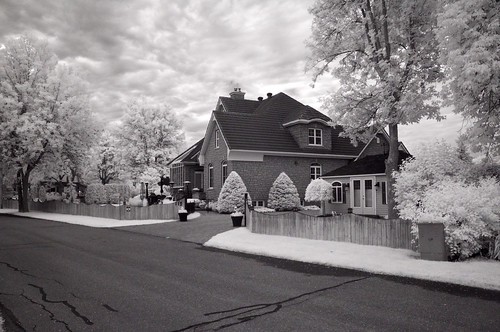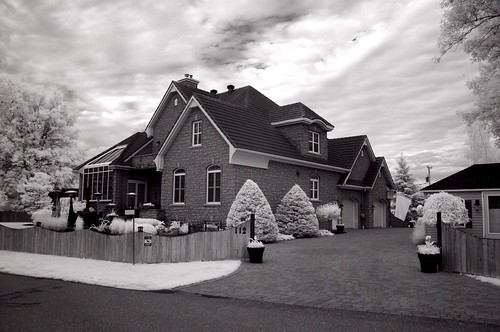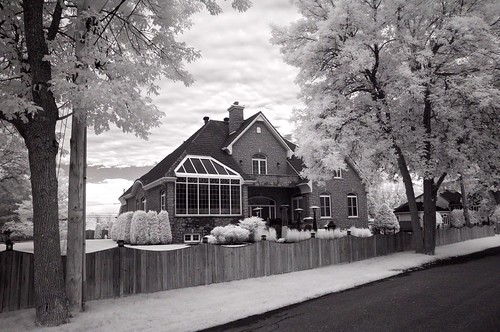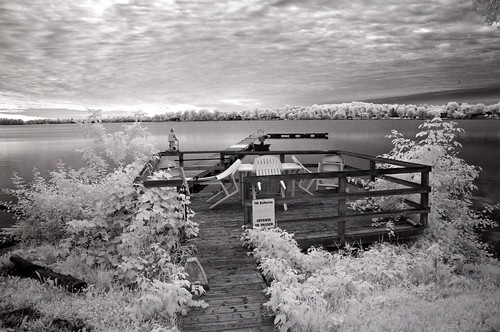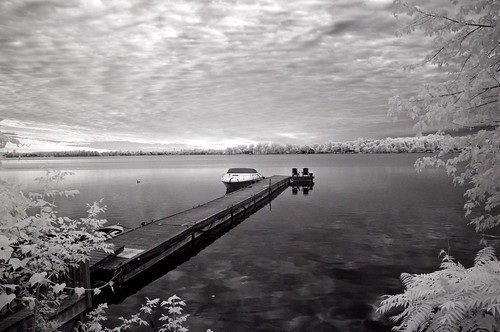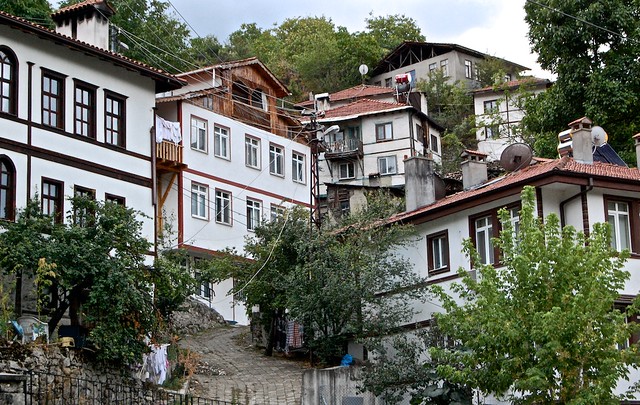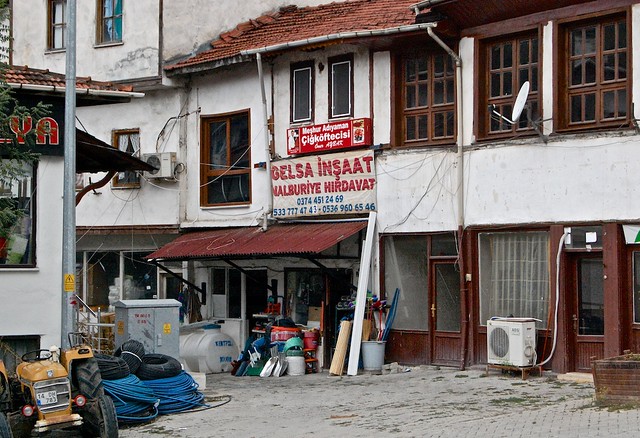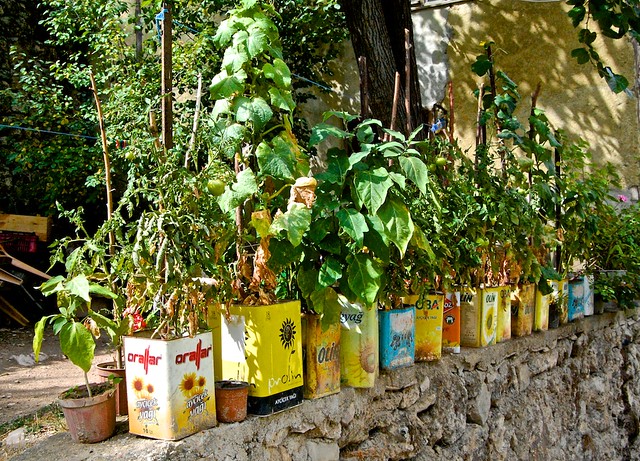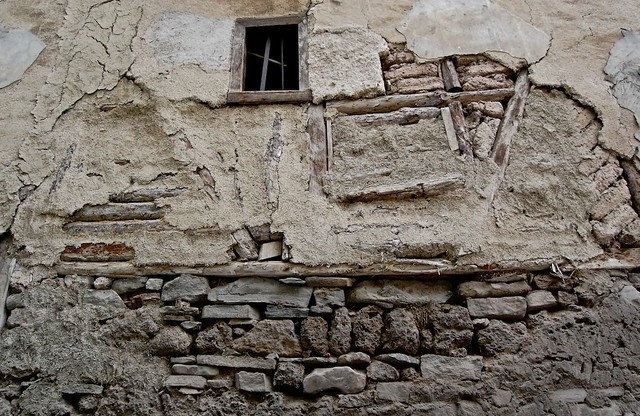I’ve started to build oook.info/lexicon/ to contain the project that I’ve been gathering material for at oook.info/etc/lexicon.html. I expect it will summarize a sprawling domain of explorations, just right for a winter month.
Category Archives: vernacular
The Earnest and the Bogus: Of “Folk Revival”
I was brought up short today by Alex Abramovich’s “Even When It’s a Big Fat Lie” in LRB, a review of Ken Burns’ Country Music, when I realized that I had been blithely ignoring the counterfeit nostalgia and encoded racism that clings to (or is perhaps at the core of) the genre. Music does carry multiple messages, serves various purposes, and is heard and interpreted in multifarious ways by different audiences and at different times. None of that should surprise—it’s just what Culture does, and there are cognate issues of the Dark Underbelly in Blues, in Rock’n’Roll, in the the various worlds of jazz, in “folk music” generally, and in High Culture musics too. There’s plenty of opportunity to descry the Emperor’s Clothes at work, and to call out various -isms on display, if that’s where one’s interests bloom.
My paths into these issues were via genres that might sustain the labels “ethnic” and “folk” and that partook of the early-1960s Harvard Square ferment so well documented in Eric von Schmidt and Jim Rooney’s Baby Let Me Follow You Down: The Illustrated Story of the Cambridge Folk Years. Robert Cantwell’s When We Were Good: The Folk Revival broadens the focus, and Scott Alarik’s Deep Community: Adventures in the Modern Folk Underground kicks out the jambs with a collection of 10 years of articles from The Boston Globe, which also ventures into English and Irish folk realms. Another dozen or so books on specific performers and groups clamor for inclusion in this canon, and may find their way in as we proceed.
There are essential compilations of music, like Harry Smith’s Anthology of American Folk Music and its sequelæ and (most recently) American Epic (also a PBS video series). And scores of others, CD and vinyl, on my shelves. These are revenants of commercial 78RPM records from the 1920s and 1930s, remastered and alive again. Amanda Petrusich’s Do Not Sell At Any Price: The Wild, Obsessive Hunt for the World’s Rarest 78rpm Records is a fine introduction to the world of collectors, whose essence is skewered by R. Crumb (who is one of Them himself…):
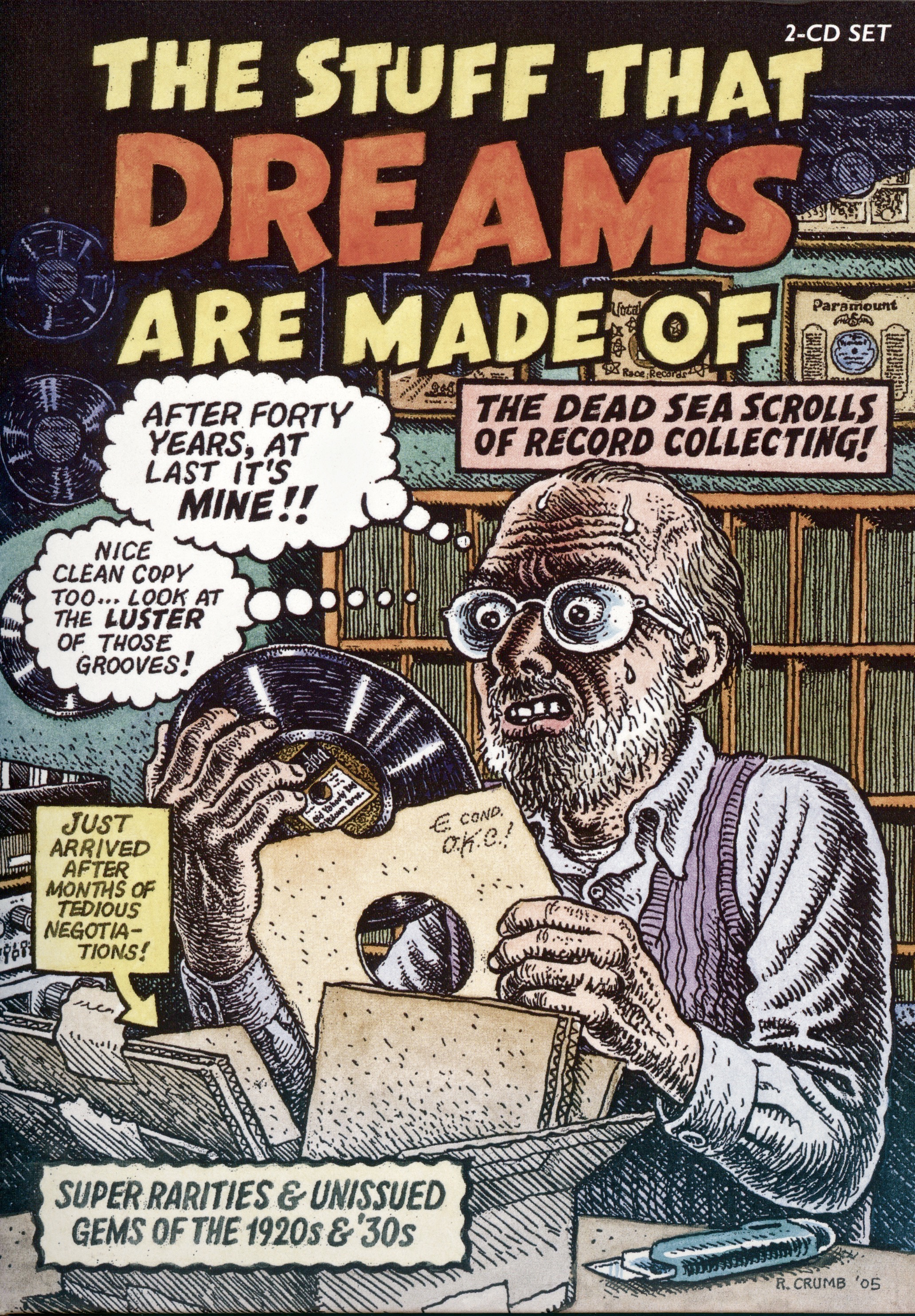
Capturing the essence and visceral meaning of folk demands attack on multiple fronts, and John Szwed’s Alan Lomax: The Man Who Recorded the World is one port of entry.
…Alan’s public influence reached its peak between 1940 and 1960, when he was the single greatest force in bringing folksongs to American awareness… At times his influence can be seen in the distortions of the funhouse mirror of American culture, where a hard-fought idea can be perverted through the countervailing forces of social and technological interests and the discourse of fashion…
To those who knew Alan’s work only from his songbooks he seemed to be the pied piper of the folk, a kindly guide for a nostalgic return trip to simpler times.But he might have thought of himself as spokesperson for the Other America, the common people, the forgotten and excluded, the ethnic, those who always come to life in troubled times… those who could evoke deep fears of their resentment and unpredictability. At such times folk songs seemed not so much charming souvenirs as ominous and threatening portents. (pp 390-391; 3)
Robert Cantwell reflects on the experience of my own age cohort, we who were born during World War II:
…I remembered lovely Joan Baez, with her dark eyes and hair, her delicate shoulders, warbling to the plinking accompaniment of her guitar some British ballad in a voice somberly and exquisitely pure; images of Bob Dylan, the real inventor of punk, brazen, wasted, outrageous, excoriating racists and warmongers and capitalists in the drawling, swearing, muttering, doggerel-ridden songs we adored, and in the elliptic, visionary, lyrical ones that remade our world, but most of all felt again the defiant spirit in which we listened to them and the sense of strength and indomitability they gave us. (pg 15)
What wants explanation for me, and I trust to many of my readers, is the seven-year period between the release of the Kingston Trio’s “Tom Dooley” and Bob Dylan’s appearance at the Newport Folk Festival in 1965 with an electric guitar and a blues band. These are artificial but not arbitrary points; by general agreement they mark the boundaries between which a longstanding folksong movement, with elaborate political and social affiliations, emerged out of relative obscurity to become an immensely popular commercial fad, only to be swallowed up by a rock-and-roll revolution whose origins, ironically, it shared. (pp 20-21)
[I] declare that folksong, whether high or low, old or new, traditional or original, survived or revived, refects the deepest and most persistent of human dreams, and marks the human face and human habitat with their power. Often it is poetically subtle and precise, melodically and harmonically striking and fresh, elegant formally and structurally sturdy and ingenious, in performance a source of lasting inspiration and intense joy. Within its basic simplicity there is, in execution especially, a complexity that will always defy analysis. (pg 44)
The tunes I still attempt to play, the recordings that moved me, this or that unforgettable performance, have assumed over time nearly the status of persons—like brothers or sisters, perhaps, in whom one inevitably catches the old family resemblance, with whom one can always become reacquainted, in whom time collapses in upon itself, and yet who must finally remain independent, other, unconquerable. We cannot, finally, abandon them—for as surely as we must relinquish our youth, so must we honor and sustain the life force that is the gift of youth. As in any youth movement, what drove the folk revival was sheer erotic magnetism and beauty, idealism and aspiration, personal, social, and political striving, forces that, perhaps more than any other art, music is capable of communicating. (pp 45-46)
And von Schmidt and Rooney capture the feeling in the Cambridge air at the start of the 1960s:
Listening to music and trying to play and sing a few songs started to become more important than whatever was going on in school. For some it became a passion that started to smoulder inside. It was at this point that certain individuals made a difference. Some were teachers, some were organizers, some were sources of energy, instigators, and others were simply talented, musically gifted.
So, where no scene had existed before, one came into being. What had been smouldering before burst into flames. Jan Baez was the most prominent member of a group whose numbers were growing daily, as were their abilities as musicians and performers. More important still was the fact that there was an audience for this music. People wanted to hear it. It filled some need that we all shared in common before we ever knew what it was. Whatever plans we might have had before were to be totally changed. (from the Foreword)
Quintessential for me has been the New Lost City Ramblers: Mike Seeger, John Cohen, Tom Paley (replaced in 1963 by Tracy Schwarz). The Early Years 1958-1962 is a good introduction, and the liner notes are an essential accompaniment. An extract:
The New Lost City Ramblers will leave barely a blip in the history of the entertainment business, as they predicted in their jokes about their “long-playing, short-selling” albums on the Folkways label. But they have nevertheless earned the touch of immortality for their central role in our discovery of the folkloristic riches preserved electronically in the early years of our century. As individual performers, Mike Seeger, Tom Paley, and John Cohen had during the 1950s become interested in performance style in American folk music, exactly that dimension of the music which recordings uniquely capture. In 1958 they formed The New Lost City Ramblers with the explicit intention of performing American folk music as it had sounded before the inroads of radio, movies, and television had begun to homogenize our diverse regional folkways.
They studied and learned from commercial 78 rpm discs of “hillbilly” musicians recorded in what has come to be called the Golden Age (1923–1940), from blues and “race” records of the same era, from the bluegrass recordings of the post-war period, from the field recordings on deposit in the Library of Congress. In turn, they began their own field trips to seek out and record and learn the music of older rural musicians who still played and sang in the old way. Over the next twenty years, the Ramblers poured forth a steady stream of their own performances live and recorded, albums of their field recordings, and festival performances and workshops in which they introduced musicians they had met in the South to urban audiences of the folk song revival of the 1960s. Their lasting influence was greatest upon a relatively small but important part of that urban audience—those few who wanted not only to study the music seriously, but who also wanted to learn to play the music themselves, actually to be the heirs of a musically rich American culture which by the 1960s largely existed only in the scratchy echoes found on primitive recordings, and in the memories of an ever-fewer number of elders.
in the parlance of our time
As I recently commented to a friend via email, I’m realizing that I enjoy, indeed revel in, a broad interpretation of ‘folkloric’ which takes in “the parlance of our time” (Lebowski reference) in all its guises.
Among the tools at my fingertips:
- Roger’s Profanisaurus Rex (“the King of swearing dictionaries”) (see 5. Book Review if you dare: “…an indispensable work of reference for students of contemporary linguistics, socio-cultural commentators and dockers who have just hit their thumb with a hammer.”)
- Green’s Dictionary of Slang in its digital edition (“Five hundred years of the vulgar tongue. ‘Quite simply the best historical dictionary of English slang there is, ever has been […] or is ever likely to be’.”)
- Expletive Deleted: A Good Look at Bad Language
- The F Word
- Barrelhouse Words: A Blues Dialect Dictionary
- Dent’s Modern Tribes: The Secret Languages of Britain
- Speaking American: How Y’all, Youse, and You Guys Talk: A Visual Guide
…and others re: various dialects of English.
(for more on parlance, see In the parlance of our time and Repetition in The Big Lebowski)
Polyglot’s Lexicon: a Rabbit Hole
Word books are often curious, in one or another of the OED’s senses:
5 c. Devoting attention to occult art. Obsolete.
1549 N. Udall et al. tr. Erasmus Eph. in Paraphr. New Test. Argt. That Citie was full of Curiouse menne, and suche as were geuen to magicall artes.
1578 T. Tymme tr. J. Calvin Comm. Genesis 35 Certaine courious persons abuse this place to colour their vaine prognostications.
1606 Bp. J. Hall Heauen vpon Earth 191 Curious men, that consult with starres, and spirits for their destinies.15. Calling forth feelings of interest; interesting, noteworthy. Obsolete or archaic.
1682 Bp. G. Burnet Hist. Rights Princes (new ed.) iv. 135 The curiousest Remains of former Ages that are extant.
1759 J. Reynolds Idler 29 Sept. 305 It is curious to observe, that [etc].
1793 J. Smeaton Narr. Edystone Lighthouse (ed. 2) §56 [It] would have been not only curious, but useful, had it been handed down to us.
1816 M. Keating Trav. (1817) II. 80 It would be very curious to be able to ascertain where and how the scaffolding was obtained for such a work.16 a. Deserving or exciting attention on account of its novelty or peculiarity; exciting curiosity; somewhat surprising, strange, singular, odd; queer. (The ordinary current objective sense.)
1715 J. Richardson Ess. Theory of Painting 100 This is very Particular, and Curious.
1719 J. Richardson Sci. Connoisseur 204 What is Rare, and Curious without any Other consideration we Naturally take Pleasure in.
1769 E. Burke Observ. Late State Nation 52 A most curious reason truly!
1807 G. Crabbe Parish Reg. iii, in Poems 115 No curious Shell, rare Plant or brilliant Spar, Intic’d our Traveller.
1868 C. W. Dilke Greater Brit. II. iv. 163 Seated in the piazza..I had before me a curious scene.
1888 J. Bryce Amer. Commonw. III. xc. 251 I give here a few of the more novel or curious provisions of the Constitution of California of 1789.
One from the shelves is all-of-the-above: Polyglot’s Lexicon 1943-1966, ascribed to Kenneth Versand, with a Preface by Kenneth Schlossberg (1973) (“[Portions] originally compiled by the Research Committee on New Words of the American Dialect Society and by G. & C. Merriam Company … [and] published annually from 1943 through 1966 in the Britannica book of the year.”).
This purports to be a presentation of “new words, new meanings, extended meanings of old words, or combinations of old words”, arrayed by year, by Science, by Politics, by Grammar (nouns, verbs, adjectives) and so on. About 2/3 of the pages are line-printer output, indicating that this was one of those early uses of mainframe computers to deal with text (which takes me back to the days of Phil Stone’s General Inquirer Project at Harvard, “a computer-assisted approach for content analyses of textual data”). The original input material would have been on punch cards (lots of punch cards), and the computer’s task was to sort the fields of the cards and output ordered lists. Here are a few page images to ponder:
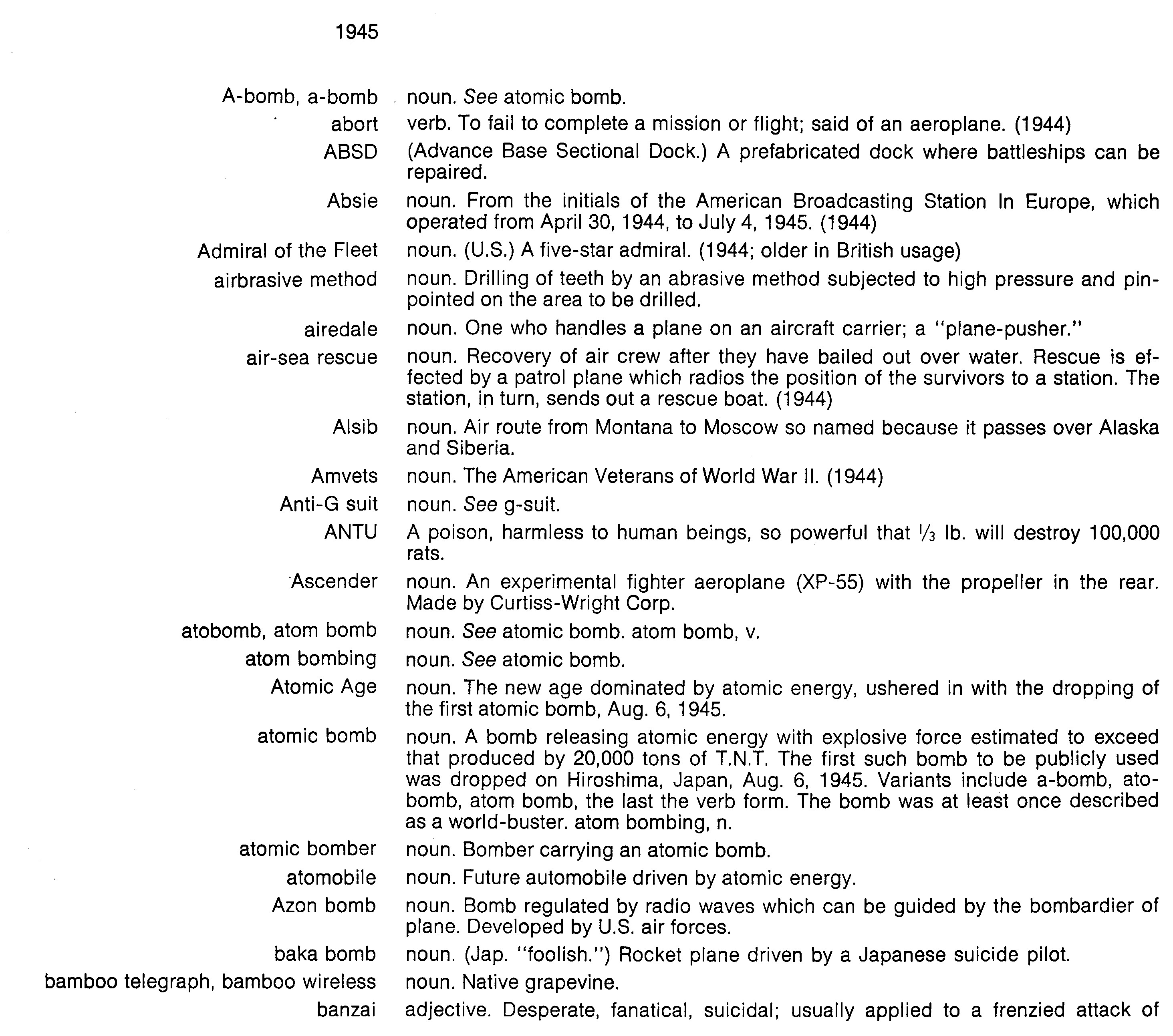
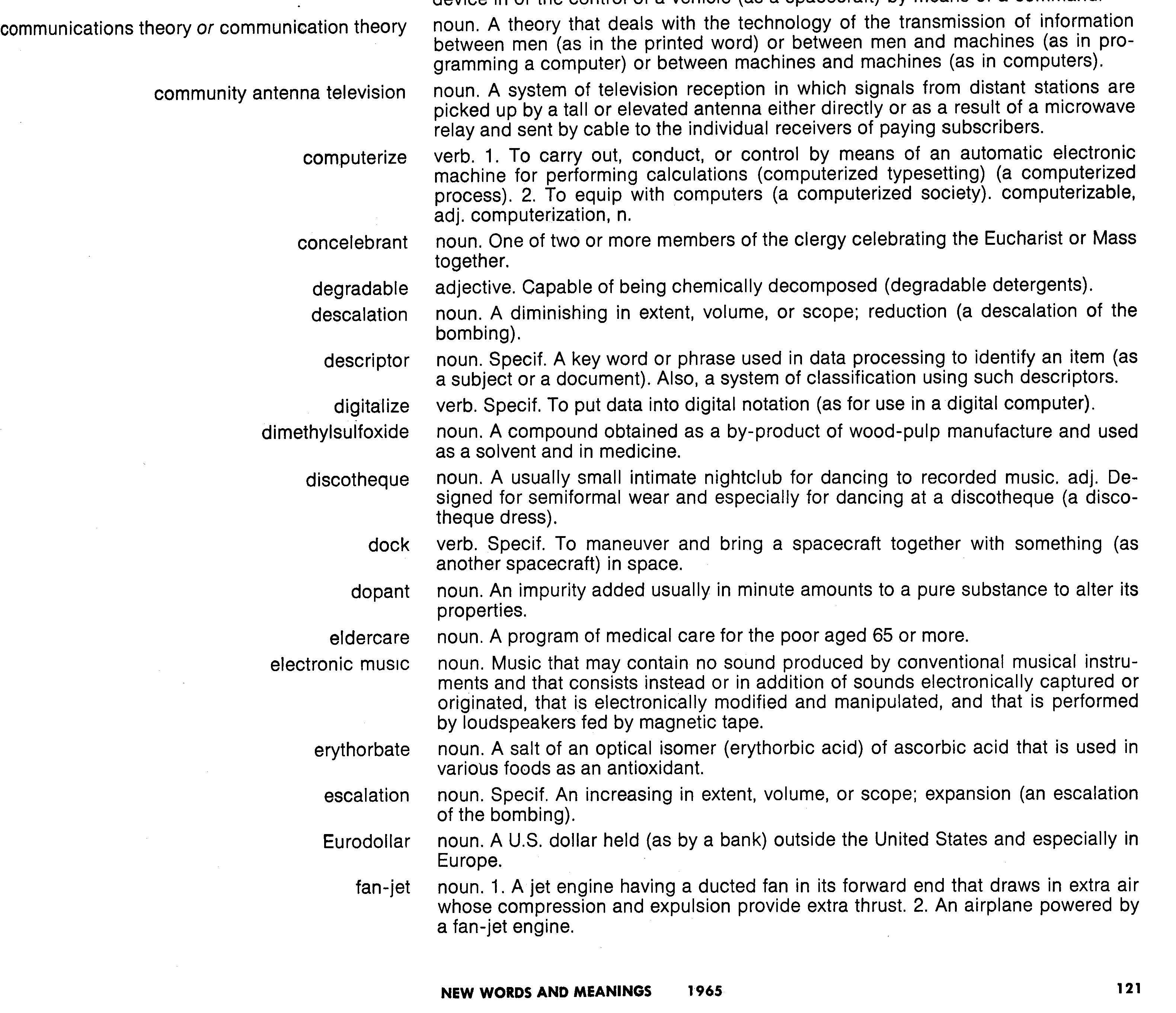
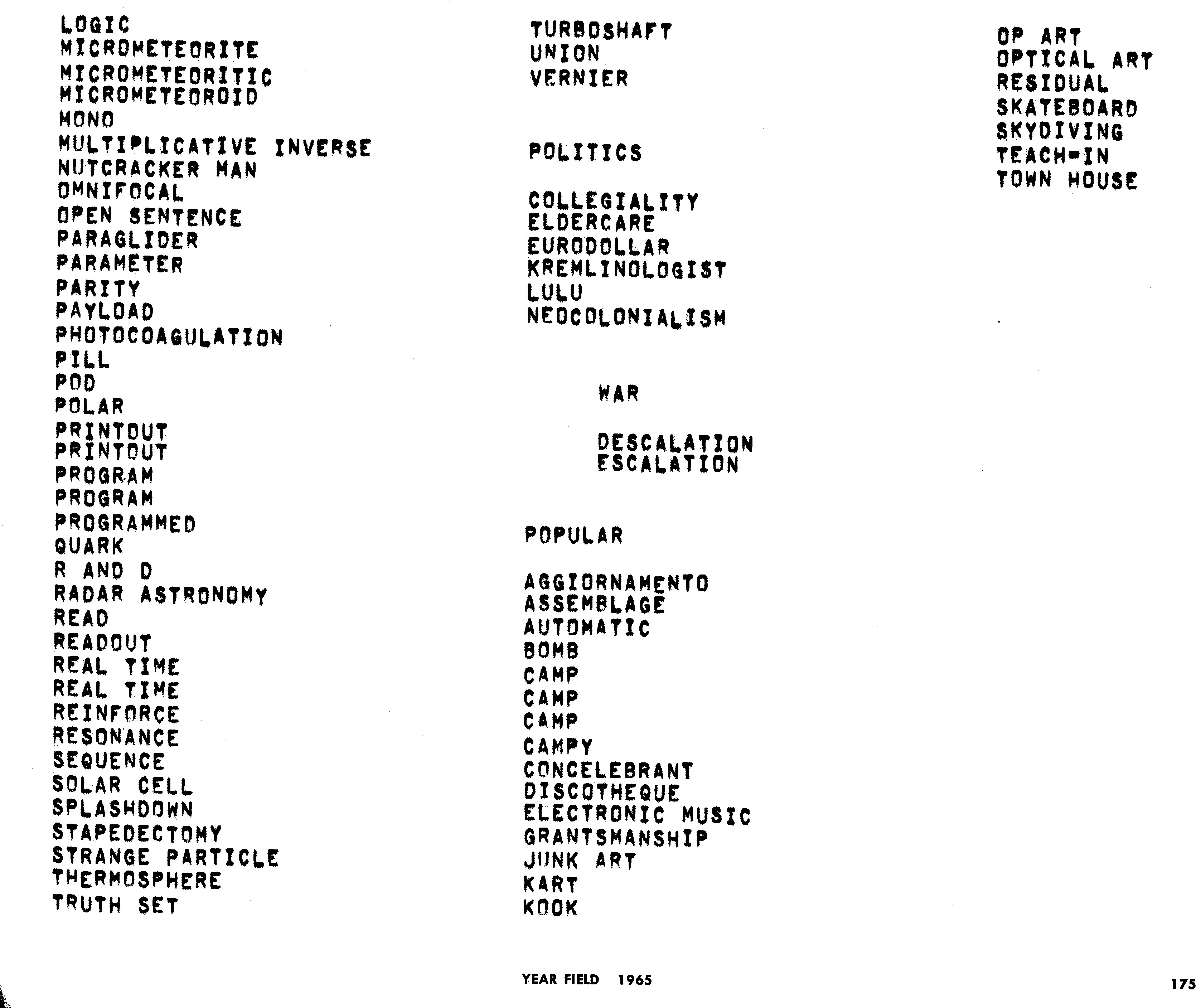

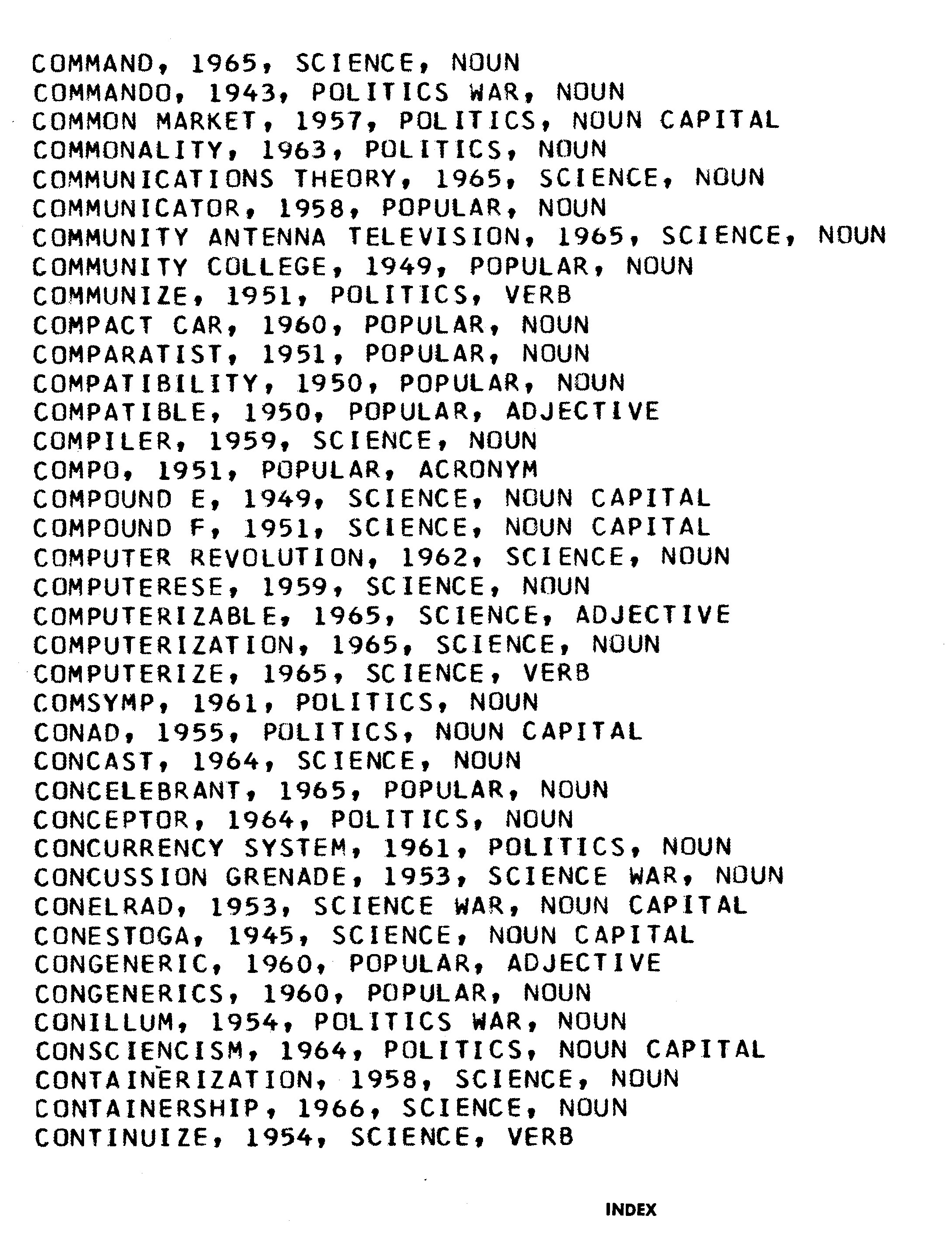
And what’s the use of such a compendium? When and how is it useful to discover that “white sidewall haircut” (‘A haircut in which the hair is clipped short on the sides’) appeared in the Zeitgeist in 1957? Or is it just a curiosity? The Research Committee on New Words of the American Dialect Society sounds a bit unlikely, but really did exist. But how did Polyglot’s Lexicon come to be? Who was “Kenneth Versand”? (I discover that someone of that name ran a STOP sign in California [“Rolling stops (or so-called ‘California stops’) are not permissible under VC 22450]”) It seems quite likely that “Kenneth Versand” is a nom de guerre of Edwin Schlossberg, and he is (since 1986) the spouse of (wait for it…) Caroline Kennedy. YCMTSU. In 1973 (when Polyglot’s Lexicon first appeared) Schlossberg was 27 years old, with BA and MA degrees from Columbia, on his way to becoming an “interactive designer” and Founder of ESI Design (see a summary profile; and see also a New York Times article from 1986). And then have a boo at his 1967-68 piece Among the Words, from Wordswordswords. In these contexts, his Preface to Polyglot’s Lexicon is almost comprehensible, considered as word art:
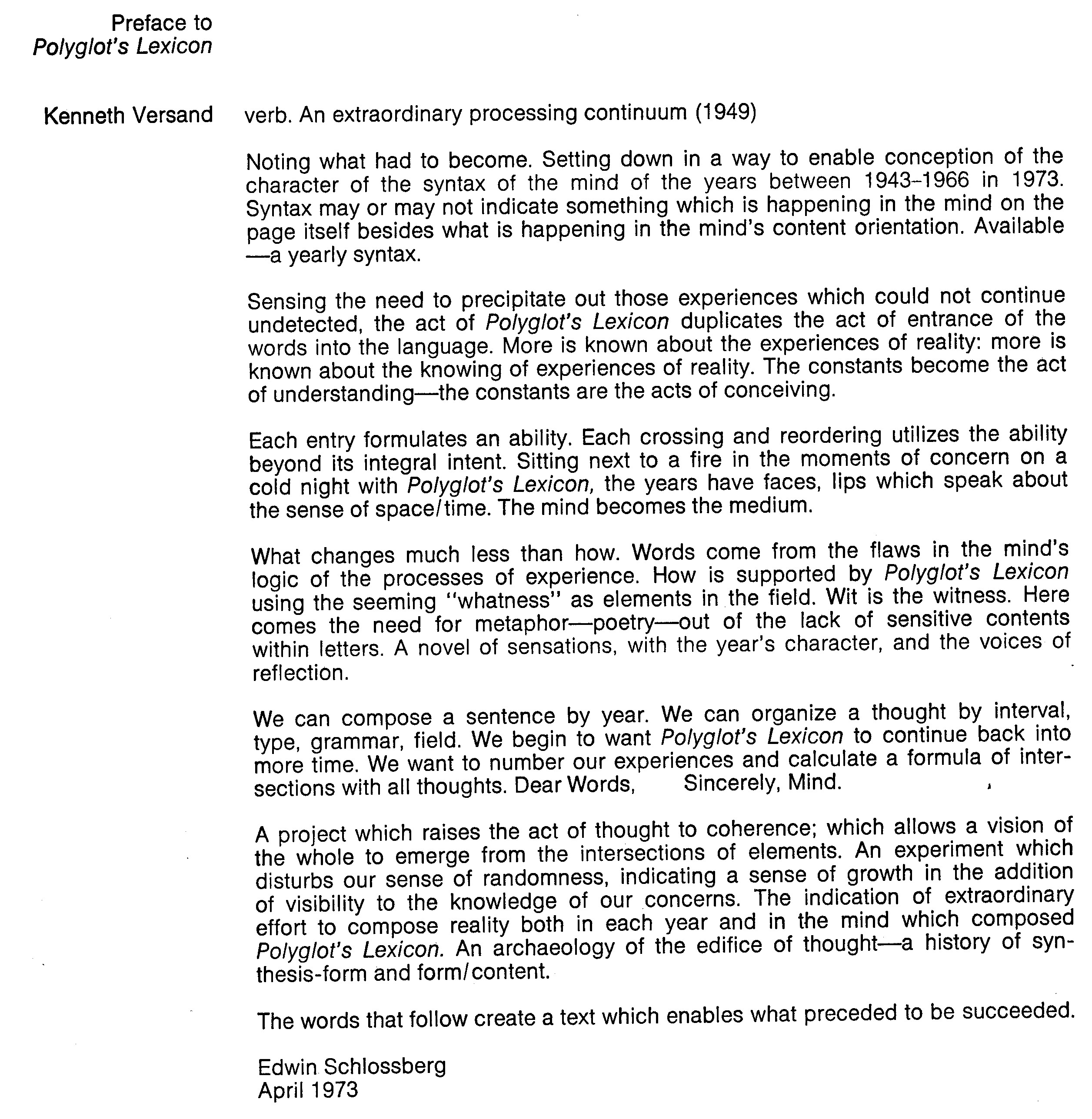
…but the Introduction, ascribed to Kenneth Versand, defies efforts to parse:
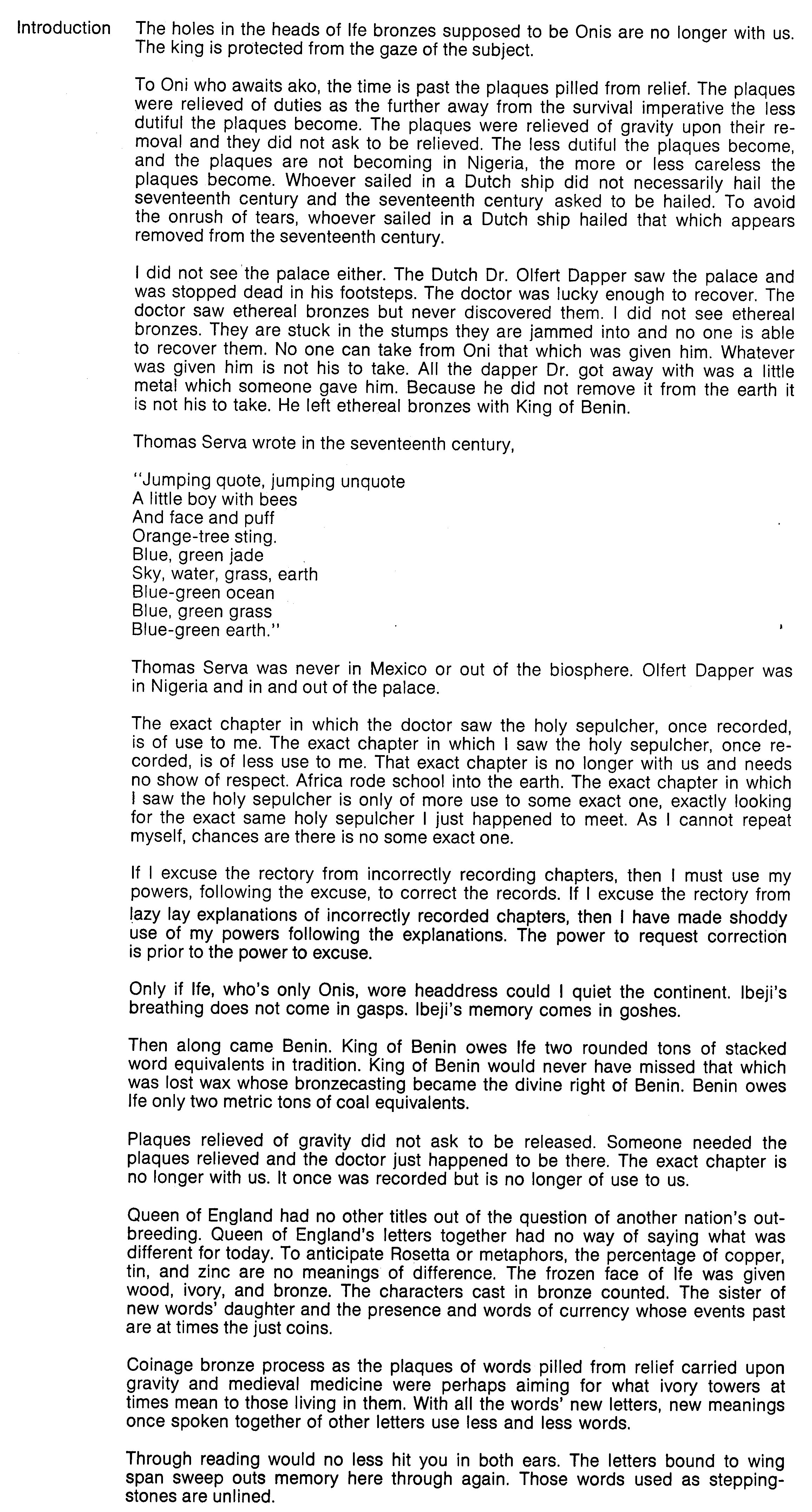
So we’re pretty far down the rabbit hole here, and who knew, when I pulled the book off the shelf to explore for this post, that such sport was to be found? Others have trod this path:
The preface is written by Edwin Schlossberg, and I wonder if he is really the author as well. ‘Versand’ is a German word for ‘ship, dispatch’ and not really a name. This fits in with Edwin Schlossberg’s projects in the 1960s when he was friends with Jasper Johns and Rauschenberg and John Cage and worked for R. Buckminster Fuller. Since he is a very famous and very private person (married to Caroline Kennedy) I think it would probably be pretty difficult to contact him to ask about the book. (https://syntopia.wordpress.com/polyglots-lexicon-an-introduction/)
Peri-urban domesticity in infrared
We chanced to spend the night in a motel in Vaudreuil-Dorion, at the confluence of the St. Lawrence and Ottawa rivers, a half-hour commute to downtown Montréal.
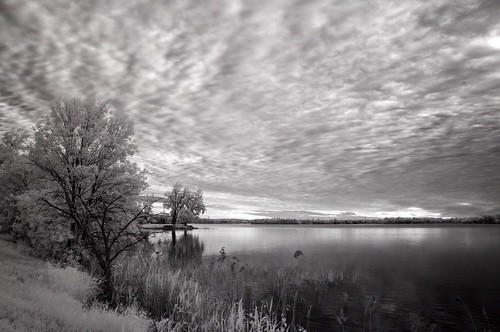
Along the rivers are houses that enjoy docks on the water, and that give full scope to Quebecois architectural styles. Consider this magnificent faux-château Trianon, and imagine the pride of its owners:
This house’s dock is middling-modest:

And other nearby neighbo[u]rs express themselves variously:

Another new project: Abandoned Ancestors
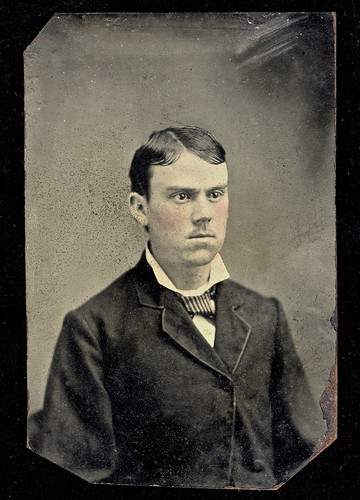
Over the years I have collected lots of pictures of unknown folks, the most coherent subset of which is arrayed in Nova Scotia Faces and also configured as a book, Bluenose Physiognomy. The images that have no direct relation to Nova Scotia need their own site, so that I can begin the process of organizing them into a book. The springboard is a separate suite of web pages, which I expect will sprawl and interdigitate in the by-now-familiar mode. The beginnings are available at Abandoned Ancestors. Stop by for a look.
on the Harmless Drudge account
another passage from Jonathon Green’s Odd Job Man
The slang lexicographer is by very nature a voyeur. The lexis undoubtedly leans toward pimping and prostitution, crime and imprisonment, violence and cruelty, drugged and drunken debauches, but the lexicographer is neither whore nor thief, thug nor prisoner, addict nor drunkard. Or not professionally. They are linguistic reporters, except that unlike the tabloids’ traditional formula they make no excuses and they do not leave. The job is to collect knowledge, to explicate it, and to disseminate the information that emerges. As I say, a voyeur, but ideally an informed one. (pg 38)
Green’s Dictionary of Slang
A week or two ago I saw the announcement for Green’s Dictionary of Slang in its online version, and almost bit (at about $60/year). Intrigued, I looked on Amazon and (1) found that the 3-volume print version could be had for a bit less than $600 via Prime, and in used form for around $300; and (2) that Jonathon Green’s Odd Job Man: Some Confessions of a Slang Lexicographer (2014) was about $4, plus shipping. I ordered the latter, and started reading it when it arrived. Fantastic so far, and I’m only 20-odd pages in. His first substantive chapter (‘Beginning’) is a fascinating and utterly unique take on autobiography, raggedy bits of wry memory:
This is in no way a conventional memoir, but some things must be said. Or so it seems to me, whose working life is so committed to searching the past for origins and roots. It is a beginning that, without the memories that those from more settled lineages have on tap, has always seemed abrupt. Perhaps, like newly arrived immigrants looking forward to their future and rushing to move beyond the past, the young have no interest in asking questions about ‘before’? Perhaps that was merely me? I failed to ask and remain in ignorance. And since the past was quite literally another country, and that country no longer exists remotely as it was, I am not going to find out. I have been trying to make up for it, by proxy, ever since. (pg 15)
A quick calculation tells me that $60/year is not all that much more than $1 a week, cheap at twice the price for a subscription. So I bit. And it looks like a real winner, now that I’ve browsed a bit and tried out the various features.
Townscape in Göynük
We spent a few hours in Göynük, a small town that preserves Ottoman architecture and is built on the steep hillsides of a river valley.
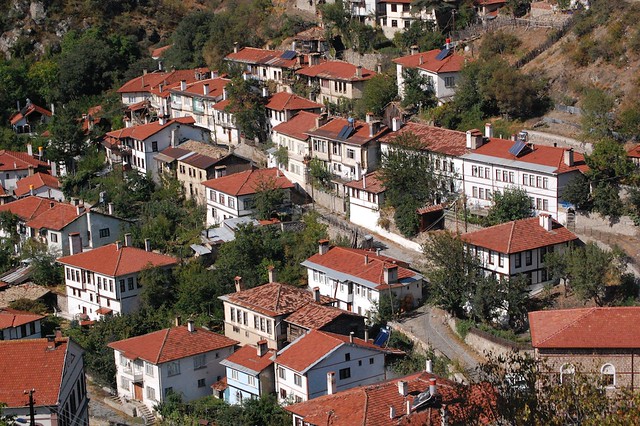
Many of the houses can only be reached by foot, via precipitous pathways that must be especially challenging in winter.
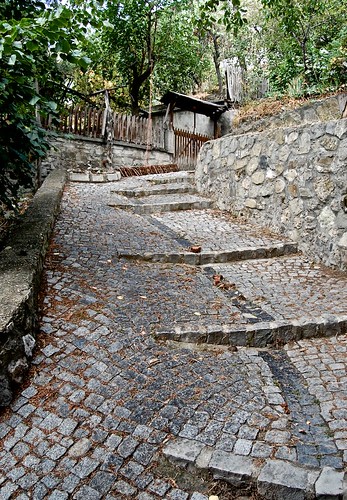
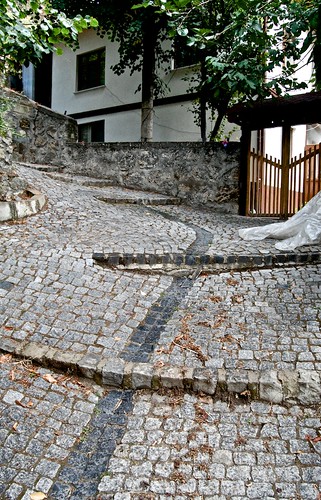

Most houses have gardens, even if they’re just some soil in an empty tin or yogurt pail:


and some are more elaborate:

It’s possible to see construction details in houses that await renovation
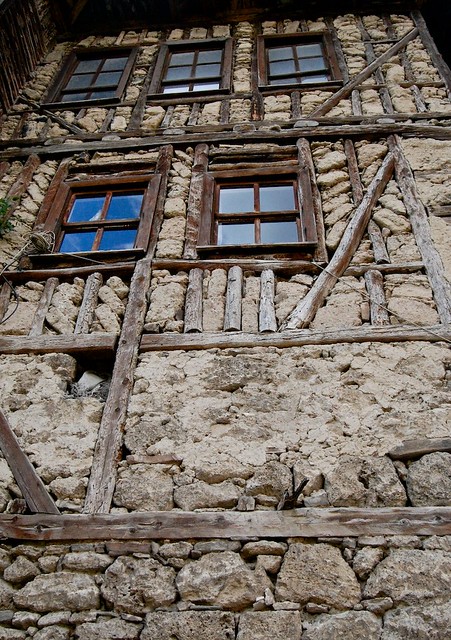

There’s lots more to be said, of course, and quite a few more Göynük images, but I think I’ll get this one launched…
